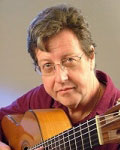R.E. Bruné was on the Guild’s very first membership list in 1972. He’s a GAL founding member, a former Guild president and board member, the organizer of our 1975 convention, and a frequent author and lecturer. He’s a classic guitar maker and dealer, flamenco artist, and father of a luthier. And a grandpa, perhaps of a luthier. We’ll see.
▪ bio current as of 2017

